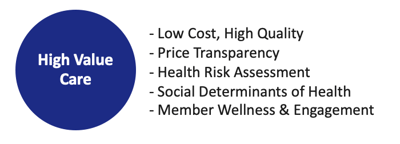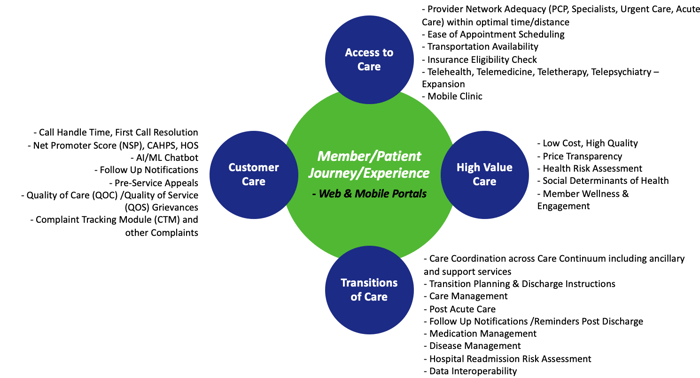In our current state of the fragmented and complex healthcare ecosystem, creating an exceptional patient experience needs a solid framework and a disciplined approach. The focus of this article is to demonstrate a patient experience framework with four pillars, which is worth giving a try before we pivot and deny.
Let’s review these four pillars, one at a time.
1. Access to Care
The patient journey starts with “Access to Care”. This is where a patient needs to outreach a provider for care–whether primary care or specialist care or acute care. No one wants to travel for long to get the care. As such, maintaining an adequate number of in-network providers close to every patient is the way to prepare.
“Access to Good Healthcare shouldn’t depend on where you live.” - Victoria Beckham
Provider availability and scheduling are equally important in this category for enhanced access to care. Expansion into virtual care (Telehealth, Telemedicine, Teletherapy, Telepsychiatry) can help maximize the value in this category and demonstrates your care is superior to other players if anyone dares to compare. A more comprehensive list of elements of the “Access to Care” pillar is shown below:

2. High Value Care
Once the patient gets the “Access to Care”, next comes the “High Value Care”. Getting the “Right Care” from a low-cost and high-quality provider isn’t easy but also not rare. With the recent focus on the patient experience from various healthcare governing institutions, patients are not unaware, and they now have access to tools and data to compare. Recent laws on price transparency are also gaining a lot of momentum. Managed care plans should constantly review their in-network provider performance (low-cost, and high-quality) based on the patient’s entire episode of care and not through the lens of siloed/single encounters. To excel in this category, plan for a better wellness and engagement program in a gamification or rewards-based environment to not only make the patients aware that you really care but also drive down the overall cost of care. Per WHO, and several other healthcare regulatory agencies, physical inactivity is one of the top five leading risk factors for global mortality. Employer sponsored health plans have already begun to invest in wellness programs. There is an opportunity for every managed healthcare plan to make this a priority to demonstrate their maturity in managing the patient’s journey.
“If you look at healthcare today, It’s all about the disease. It’s not about understanding wellness at all.” - Leroy Hood
A more inclusive list of elements of the “High Value Care” pillar is shown bel

3. Transitions of Care
Once the patient gets “Access to Care” along with the “High Value Care”, effectively managing any care transition need during the entire episode of care should be everyone’s ambition to improve patient’s condition. “Transitions of Care” refers to the patient moving from an outpatient to an inpatient setting or vice versa. Digging deeper into the various settings, it includes–Ambulatory/Outpatient, Inpatient Acute/Emergency Care, Post Acute Care, Long Term Support Services (LTSS), Rehabilitation Centers, Home Health, etc. In general, any care transition from one setting to another falls into this proposition. During this transition of care, well-planned (from provider) and well-understood (by patient) discharge instructions are essential additions. Great care coordination across the entire care continuum (including any auxiliary, and support services) during the patient’s entire episode of care is required to transpire a superior patient experience. Follow up notifications and reminders post discharge needs minimal technology investment but will be extremely tactful for an impactful “Transitions of Care".
“In many cases, the success or failure of value-based care is largely driven by care coordination processes, which impact your ability to communicate and manage patient transitions & referrals.”- TCurtis Gattis
Due to the heavy load on providers and health systems, digital data interoperability is critical for clinical success in this category. A more comprehensive list of elements as part of the “Transitions of Care” pillar is shown below:
4. Customer Care
Last but not least, having great “Customer Care” is non-negotiable to show your support if patients need to report any issue or seek any help while they navigate through various gates in our complex healthcare system. Providing emotional support to the patients during their care call is worthy of exhibiting your superior care. In managed care organizations, there is often a drive to reduce the Average Handle Time (AHT) and increase the First Call Resolution (FCR) metrics. They believe doing this demonstrates their superiority in managing customer care operations with efficacy. In a mad rush to get better at these metrics, the quality of customer care gets skeptics which sets a bad score in the customer satisfaction survey results. From a managed care perspective, CMS (Center for Medicare and Medicaid Services) has recently assigned a heavy weight to the CAHPS (Consumer Assessment of Healthcare Providers & Systems) survey measures as part of their Medicare 5-Stars rating program. With time, this weight on customer satisfaction will only become great. As such, AHT and FCR should be weighed in together with Net Promoter Score (NPS), CAHPS, HOS (Health Outcome Survey), and other Customer Satisfaction survey results. Showing empathy and compassion on every customer care call is a win-win for both the patient and the health plan.
“If compassion is so good for us, why don’t we train our healthcare providers in compassion so that they can do what they’re supposed to do, which is to transform suffering.” - Joan Halifax
Remember to always think from the shoes of the patient on every “Customer Care” call. AI/ML driven chatbots are becoming popular these days from AHT/FCR perspective, but again the focus needs to be holistic (entire patient care journey) and not from the lens of individual “Customer Care” calls. A more extensive list of the elements of “Customer Care” pillar is shown below:

Summary
“The Four Pillars of Patient Care Journey” framework is shown below:

As a managed care organization, building lean/efficient and highly configurable digital solutions from a human-centered design perspective containing all the above pillars and elements is bound to surround you with huge success.
At last, “Caring is the essence of nursing.” - Jean Watson

.png)


